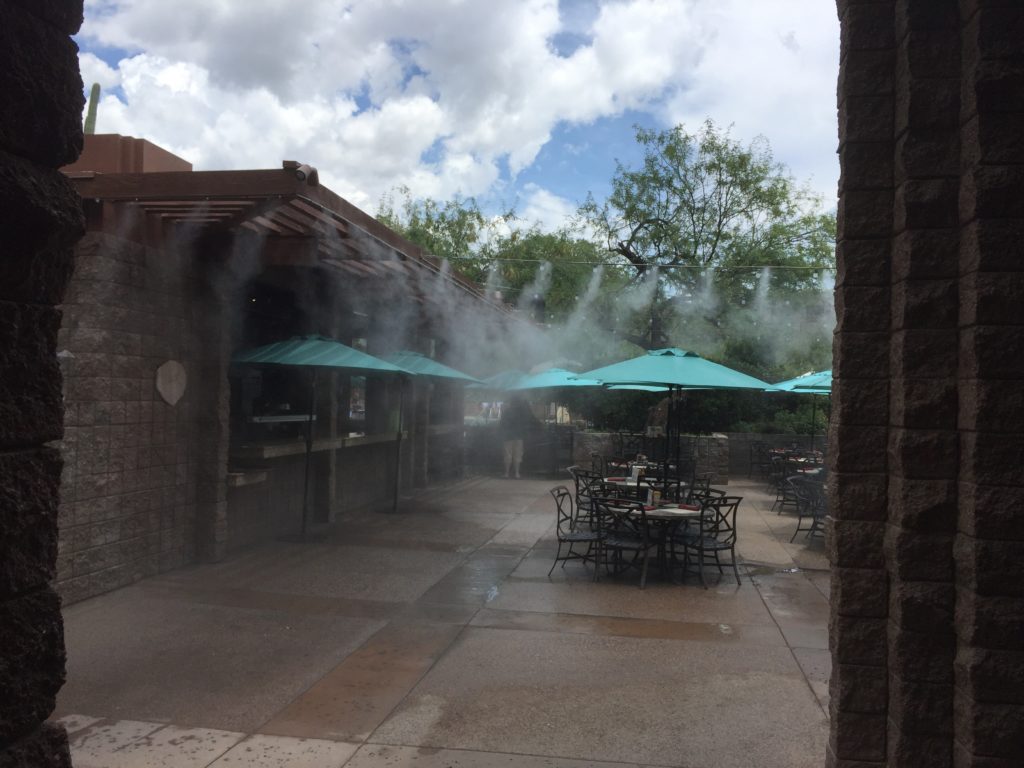When we think today about Arizona’s water problems, we imagine large lawns in sprawling suburbs in and around Phoenix, golf courses, and “misters”—those devices that fritter away water into the hot desert air to cool the customers eating at outdoor restaurants in the Valley of the Sun.
Me, in Water is For Fighting Over

Arizona misters
Lissa and I slipped away for a long weekend in Arizona before I dive into a new semester and a busy autumn. It’s hot as hell here, which means hotels are cheap, and we’re ensconced for a few days in a luxury we otherwise could not afford. Three floors down from our room, by the pool, is an outdoor bar. With misters.
The place has four pools, a waterfall, and a mountainside of saguaro. It is ripe for thinking about our complex cultural relationship with water.
One of my trip books is the architectural historian Reyner Banham’s 1971 classic Los Angeles: The Architecture of Four Ecologies. (Thanks to the amazing librarians at UNM’s Fine Arts Library, who were able to track it down for me because I really wanted to read it and they are librarians.) Banham, a Brit, brought a bemused enthusiasm to the task of making sense of the architecture and urban form of Los Angeles. Water, while only briefly discussed, is foundational:
Whatever man has done subsequently to the climate and environment of Southern California, it remains one of the ecological wonders of the habitable world. Given water to pour on its light and otherwise almost desert soil, it can be made to produce a reasonable facsimile of Eden.
For Banham this is not without moral weight:
But to produce instant Paradise you have to add water – and keep on adding it. Once the scant local resources had been tapped, wasted, and spoiled, the politics of hydrology became a pressing concern, even a deciding factor in fixing the political boundaries of Los Angeles. The City annexed the San Fernando Valley, murder the Owens Valley in its first great raid on the hinterland waters under William Mulholland, and its hydrological frontier is now on the Colorado River.
Banham is writing about my beloved L.A., and much of what he has to say is unique to that place. But a significant fraction generalizes to the other great cities of the arid and semi-arid Southwest – the relationship of architecture to the out-of-doors, the critical role of the freeway in the evolution of the urban form, and most certainly our relationship with water.
Driving into Phoenix on a trip last January, I experience a remarkable moment. It was a feeling of calm familiarity with the urban landscape that hit me suddenly and deeply, in a momentary flash. A split second later the cause emerged into my conscious brain – eucalyptus trees along the freeway, the tree of my childhood, a non-native that is so ingrained in my Southern California aesthetic as to seem completely native, Australian import that it might be.
Here in urban Arizona, eucalyptus and palm trees make a strong showing, one reasonably water-wise – the eucalyptus – and one profoundly not. Palm trees use a lot of water. Banham describes that mixing as “this promise of an ecological miracle that was the area’s first really saleable product – the ‘land of perpetual spring’.” Again “the area” Banham is describing is greater Los Angeles, but here in central Arizona where the hydrological frontier of the Colorado River pushed with the completion of the Central Arizona Project in the 1990s, the story is now much the same. There is much continuity among the stories of Los Angeles, San Diego, Phoenix, Tucson, Las Vegas, and Albuquerque, which I have come to think of as my cities.
On the hillside above our embarrassingly swanky resort, a small waterfall bursts over a small cliff, cascading down a rocky creek that winds past the first two swimming pools, under the hotel lobby, and out into an infinity pool overlooking the golf course.
This is a desert. Suffice to say there are pumps involved.
I have become cautious about imposing my values about which uses of water are OK and which are not. The gardens flanking the fake waterfall and creek are beautiful, a botanical garden of native vegetation well adapted to the arid climate, but far more lush, thanks to the added water, than on the real native creeks you can hike in the canyons to the east and west.
We’ve done some crazy shit with our water here in the arid Southwest. But misters?
